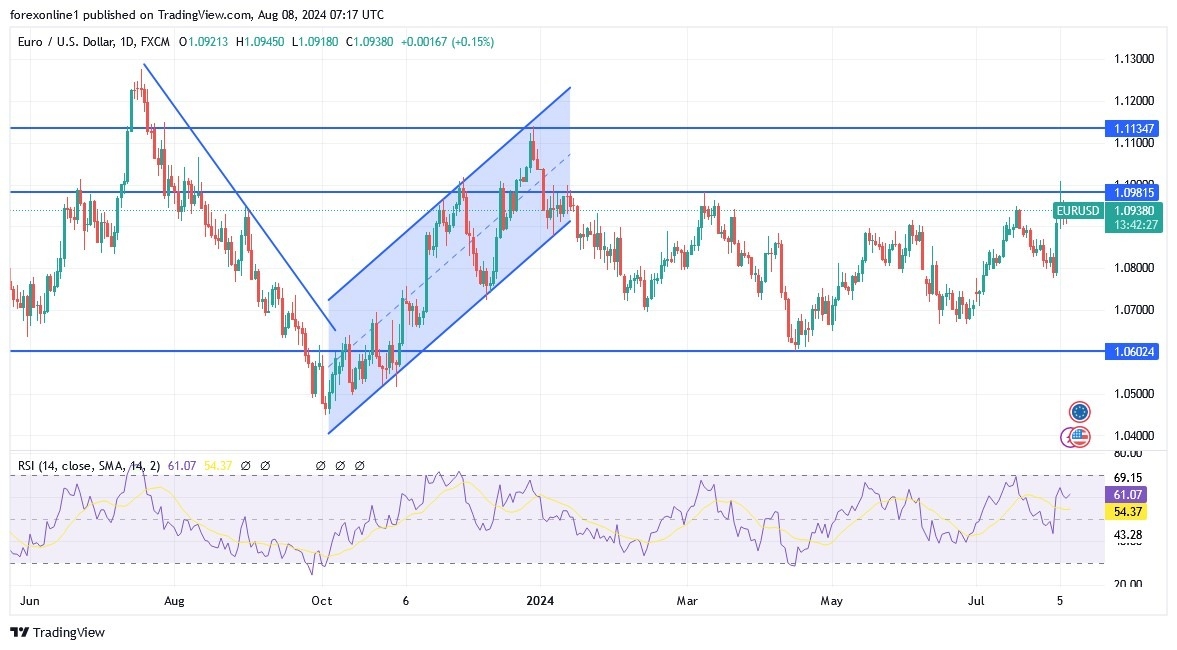- For the second consecutive day, the EUR/USD currency pair has been under selling pressure as profit-taking emerged following the pair's break above the 1.1000 psychological resistance level, its highest in seven months, at the beginning of this shortened trading week.
- Selling pressure pushed the pair towards the 1.0903 level before stabilizing around 1.0920 at the time of writing this analysis, awaiting any new developments.
- Recently, the EUR/USD has been strongly influenced by signals from global central banks regarding the future of tightening, as well as concerns about a US economic recession.
- The euro is somewhat vulnerable, but it has made relative gains. Last Friday's US jobs data raised concerns about the US economy slipping into recession.
On the stock trading platforms front, German stocks rose. Germany's DAX rose 0.8% to 17,485 points on Wednesday, tracking gains in its European peers as traders try to shake off concerns about the global economy and as Bank of Japan Deputy Governor Uchida offers investors some confidence by saying the central bank will not raise interest rates when financial markets are unstable. Meanwhile, earnings season continues with Continental up about 5% after the company delivered better-than-expected results despite cutting its full-year sales guidance due to lower car production.
On the other hand, Siemens Energy shares fell about 0.5% despite reporting a smaller net profit loss in the second quarter. Commerzbank lost about 4.6% after reporting a drop in profits and Puma fell more than 12% after reporting a drop in sales and narrowing its full-year operating profit forecast.
In the same context, French stocks break a 4-day losing streak. The CAC 40 index rose 0.8% to 7,189 points on Wednesday, snapping a four-session losing streak, supported by improved investor sentiment as concerns over the global economy eased. Also, sentiment was boosted by Bank of Japan Deputy Governor Uchida’s assurance that the central bank would not raise interest rates amid market volatility. The banking sector was among the best performers, with BNP Paribas, Societe Generale and Credit Agricole adding between 2.2% and 2.3%. Other notable gainers included Carrefour, Saint-Gobain, Schneider Electric, Renault and Legrand, which rose between 1.6% and 2.7%.
On the domestic front, France’s trade deficit narrowed to €6.1 billion in June 2024 from €7.7 billion the previous month and better than expected €7.5 billion. This was the smallest trade deficit in three months, with exports up 3.4% month-on-month to €51.7 billion, while imports fell 0.2% to €57.8 billion.
According to the economic calendar, German import growth below expectations. Imports to Germany rose 0.3% month-on-month to €107.3 billion in June 2024, after a 5.5% decline in the previous period. The latest reading was below expectations of 2.8% growth, as purchases from outside the EU fell by 0.4%, mainly from China (-4.9%), the US (-6.5%) and Russia (-1.5%), while those from the UK (-11.1%) increased. Imports from the EU, meanwhile, grew by 1.0%, supported by purchases from non-EU regions (3.7%). Looking at the January-July 2014 period, purchases contracted by 6.0% compared to the same period last year to €658.9 billion.
Also, exports from Germany fell by 3.4% month-on-month to a six-month low of €127.7 billion in June 2024, worse than market expectations of a 1.5% decline, following a 3.1% decline in the previous month, the sharpest decline since last December. According to the announcement, shipments to the European Union fell by 3.4%, driven by exports from the eurozone (-3.2%) and the non-eurozone area (-3.7%). Exports to third countries also declined by 3.5%, with exports to the United States contracting by 7.7%, while exports to Britain and Russia fell by 0.6% and 3.2%, respectively.
In contrast, exports to China rose by 3.4%. During the first seven months of 2024, exports decreased by 1.1% compared to the same period last year to 798.8 billion euros.
Top Forex Brokers
EUR/USD Technical analysis and forecast:
The neutrality of the EUR/USD price performance continues, and the bullish bias will be stronger if it returns to stability above the psychological resistance of 1.1000 again. On the other hand, according to the performance on the daily chart, returning to the support area of 1.0820 will be important for the bears to control the trend again. Therefore, we still prefer to sell the EUR/USD from every upward level.
Ready to trade our daily Forex analysis? We’ve made a list of the best forex demo accounts worth trading with.


